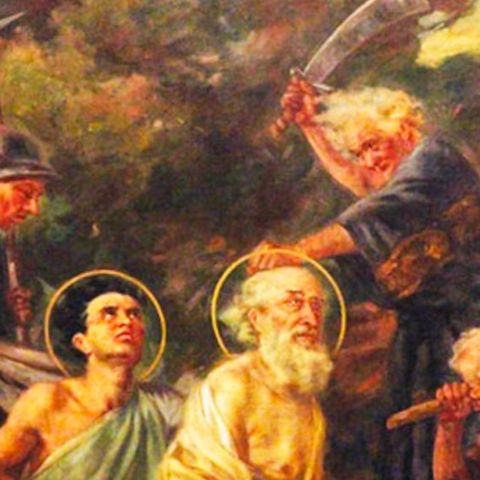June 2: Saints Marcellinus and Peter, Martyrs

Sign up for free
Listen to this episode and many more. Enjoy the best podcasts on Spreaker!
Download and listen anywhere
Download your favorite episodes and enjoy them, wherever you are! Sign up or log in now to access offline listening.
Description
June 2: Saints Marcellinus and Peter, Martyrs Mid-third Century–c. 304 Optional Memorial; Liturgical Color: Red Their memory was preserved by their very executioner Saint Helen went to the Holy Land...
show moreMid-third Century–c. 304
Optional Memorial; Liturgical Color: Red
Their memory was preserved by their very executioner
Saint Helen went to the Holy Land and returned to Rome with remnants of the true cross of Christ. This same Helen was the mother of Constantine, the Roman Emperor who legalized Christianity in 313 and who called the Council of Nicea in 325. When Saint Helen died around 328, her Emperor-Son placed her body in a monumental, sumptuous sarcophagus of rare, porphyry marble from Egypt. The deeply carved red stone shows Roman soldiers on horseback conquering barbarians. These are not scenes likely to adorn a pious woman’s tomb. It was probably meant to be Constantine’s own sarcophagus, but when his mother died, he used it for her. And Constantine did one more thing for his mother. He built a large church on the outskirts of Rome over the catacombs, or burial place, of today’s saints, Marcellinus and Peter, and placed his mother and her giant tomb inside of the church.
That one so famous and powerful as Constantine would build a church over the catacombs of Marcellinus and Peter, and honor this church still more with his mother’s tomb, testifies to these martyrs’ importance to the early Christians of Rome. And since they were martyred in approximately 304, only a decade before Constantine conquered the eternal city, their memory must still have been fresh when Christianity was legalized. Until this time, Christians worshipped in dark, hidden places. As they first stepped into the public light to build the ancient churches whose walls, pillars, and foundations are still visible today, these Christians honored those who came before them. They honored those whose deaths were all the sadder because they perished so close to the day of Christian liberation. They honored Saints Marcellinus and Peter.
Little is known with certainty about Saint Marcellinus and Saint Peter. Tradition tells us that Marcellinus was a priest and Peter an exorcist and that they were beheaded on the outskirts of Rome. A few years after the bloody event, a little boy from Rome heard about their deaths from the mouth of their very executioner, who later became a Christian. That little boy was named Damasus, and he went on to became Pope from 366–384. Decades later, remembering the story he had heard as a child, Pope Damasus honored Marcellinus and Peter by adorning their tomb with a marble inscription recounting the details of their martyrdom as he had heard them so long ago. Unfortunately, the inscription is lost.
The circumstances of Marcellinus’ and Peter’s deaths were likely similar to those of other, better-documented martyrdoms: some public declaration of faith, arrest, perfunctory trial, a chance to offer sacrifice to a Roman god, a refusal, a last chance to be an idolater, a last refusal, and then a swift, businesslike beheading. It was over quickly. Then came the calm. Then came the night. And out of that darkness emerged a candle-lit procession of humble Christians, walking slowly and silently toward the place of execution. The headless corpses were placed on white sheets and carried solemnly to an underground burial niche. A small marble plaque etched with the martyrs’ names was placed nearby. An oil lamp was lit and left burning. Thus the veneration began. Thus it continues today.
Marcellinus and Peter were important enough to be included in the official list of Roman martyrs and to have their names remembered in the liturgy of Rome. As the Mass celebrated in Rome became standard throughout the Catholic world, the names of Marcellinus and Peter were embedded into the Roman Canon, the First Eucharistic Prayer. And there they are read at Mass until today, more than one thousand seven hundred years after they died. The Body of Christ forgets nothing, retains everything, and purifies its memory to honor those who deserve honoring.
The catacombs and the first Basilica of Marcellinus and Peter fell into ruins at the hands of two enemies—time and the Goths. A “new” church was built nearby to replace it and is still a parish. Saint Helen’s bones were removed from her imperial tomb in the twelfth century and swapped with the body of a Pope. The tomb was later emptied again and, in 1777, moved to the Vatican museums. Hundreds of thousands of tourists walk right by the tomb every year, seeing perhaps just a huge chunk of marble, oblivious to the rich history connecting the monumental tomb to ancient Christianity and the martyrs we commemorate today.
Saints Marcellinus and Peter, help all those who seek your intercession to face persecution and intimidation of any kind, via words, or arms, or threats, with bravery and heroic resistance.
Information
| Author | Fr. Michael Black |
| Website | - |
| Tags |
Copyright 2024 - Spreaker Inc. an iHeartMedia Company
